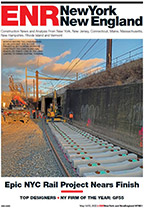The only person to be criminally prosecuted for the deadly collapse of a 200-ft tower crane in Manhattan on March 15, 2008 was acquitted last week of all charges against him.
New York Supreme Court Judge Roger Hayes’ tersely-worded verdict declared master rigger William Rapetti not guilty on a multitude of charges that included manslaughter and negligent homicide for his role in the collapse that killed seven and injured dozens more.
But with 58 civil suits still pending against Rapetti and his firm, Rapetti Rigging Services, Massapequa Park, N.Y., there is plenty of blame going around for the accident.
During the trial Rapetti’s attorney’s argued that the crane collapsed because the developer of the rising condominium on East 51st Street rushed construction during the tail-end of the city’s housing boom in late 2007 and early 2008.
In particular, the defense claimed that the crane’s installation engineer rushed the welding of the tie-beams on the building’s ninth floor, sped up on the controls on the computer controlling the joystick, and used an unorthodox design foregoing the bolting of the crane to the ground. The crane’s computer system was also revealed to have been beset with problems for months before the collapse.
Throughout the trial, defense attorney Arthur Aidala also accused New York of “incompetence at the highest levels of city government,” noting Department of Buildings (DOB) inspector Edward Marquette was indicted for saying he inspected the doomed crane when he allegedly did not.
Howard Hershenhorn, who represents the wife of victim Wayne Bleidner in one of the civil cases against Rapetti and several defendants, agrees that what he calls a “domino effect of errors” caused the crane to tumble. Unnecessarily
“This does not really appear to be solely [the fault of] Rapetti, but rather a combination of fault by several different people and entities that led to this calamity,” he says.
Steven Dorfman, the attorney for John Gallego, who testified during the trial that he was “buried alive” by the fallen crane, agrees. “In the past, everybody was trying to point the finger on Rapetti and lay the blame on him, they can’t really do that now,” he says.
He adds that his case includes owners, general contractors, and the city, as well.
“I feel the defendants in my case are the appropriate parties,” Dorfman says.
Although Hershenhorn acknowledges that the allegedly absentee inspector makes for a “sexy case against the city,” he doubts that New York City will suffer much “practical fallout” because it is difficult to prove that a proper inspection would have prevented the collapse.

